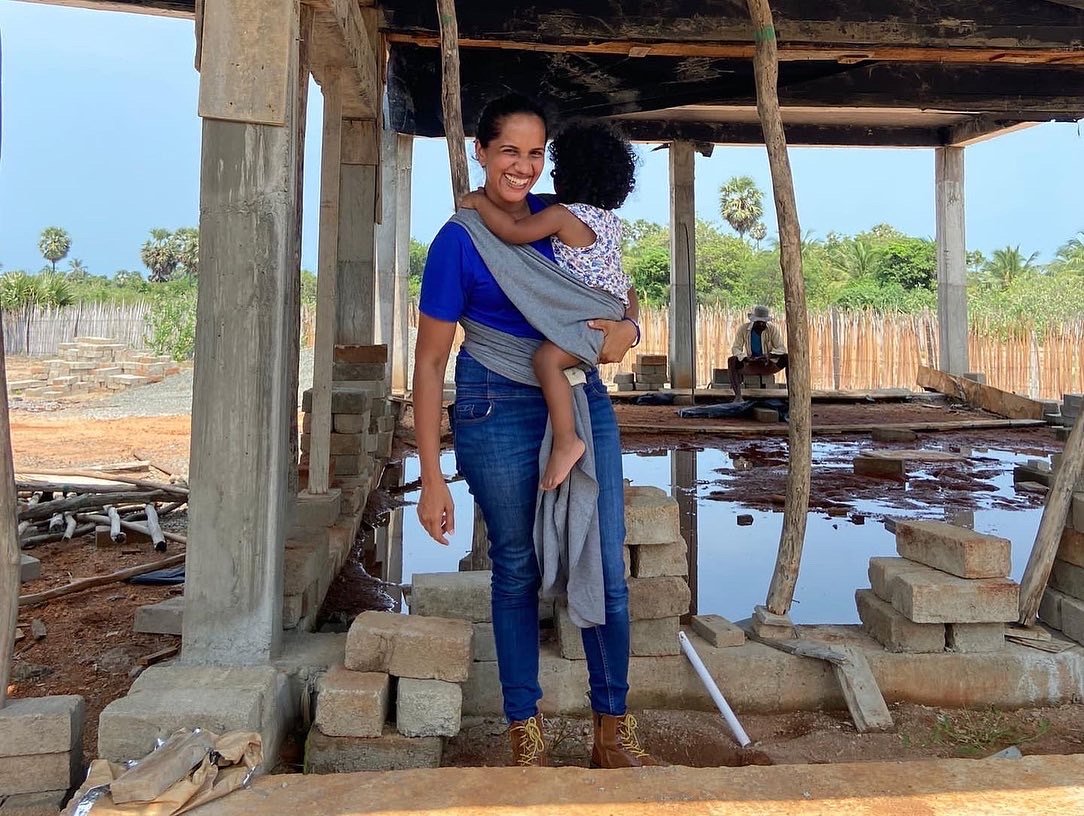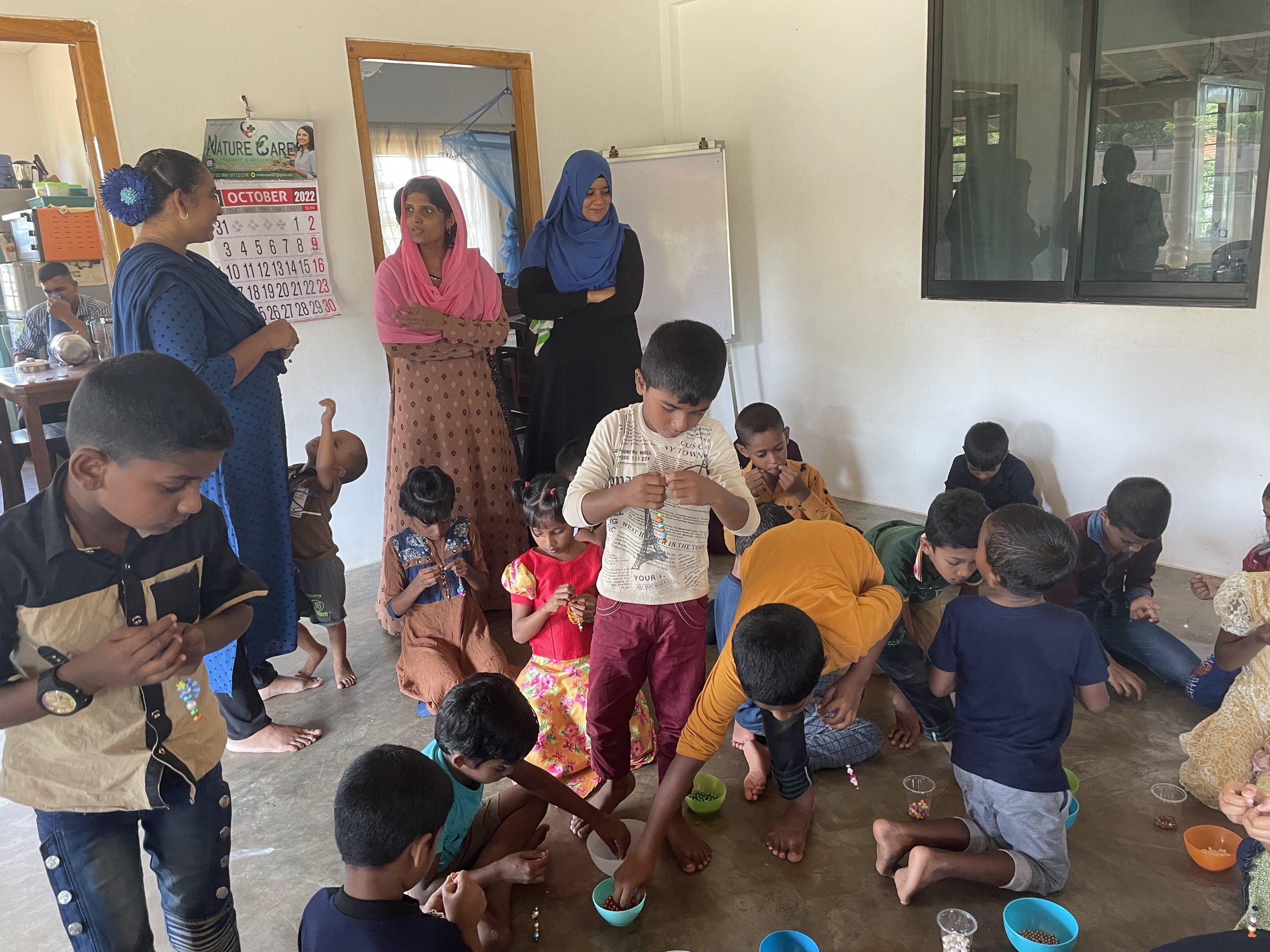My motivation behind the architecture of Little Trees Nurtury
Author: Wathmi Fernando
Editor: Elisah Sauerbier, Kintan van Leeuwen
The construction site of Little Trees Nurtury, in Puthukkudiyiruppu on Mannar Island
The construction of the future preschool “Little Trees Nurtury” is located in Puthukkudiyiruppu on Mannar island, in the Northern Province of Sri Lanka. Mannar has many stories to tell and is indeed an island full of surprises, but was heavily affected by the civil war that raged between 1983 and 2009. On the road to Mannar, the devastating effects of the decades of civil war are still evident. In an effort to rehabilitate the thousands of Tamil families, many housing developments can be seen. Upon entering Mannar Island there is an Army checkpoint which is one of the few places that remain and memories of terrible days flood in.
Mannar Island is not only a biodiversity hotspot that many today are drawn to photograph and document but within it lies a rich, intriguing history with a charm of its own. The ancient Sanskrit epics of Ramayana describe Prince Rama's journey to rescue his beloved wife Sita with the help of an army of monkeys, from the clutches of Ravana the Lankan king who was said to have ten heads and twenty arms. The army built a bridge that connects Rameshwaram Island in India to Mannar Island and is now known as Adams bridge.
Artist: Anonymous, Made in Kangra, Himachal Pradesh, India. A 19th-century painting depicting a scene from Ramayana, wherein monkeys are shown building a bridge to Lanka.
The strategic Location of Mannar is vital in the history of conquest because everyone travelling to Sri Lanka first set foot in Mannar. The Kings of India, Greeks, Romans, Arabs, Persians, Portuguese, and Dutch. This allowed it to be a booming trade port so much so that the astronomer Ptolemy in his map of Taprobane in 1477 CE made some miscalculations where he depicted the size of the continent by its great reputation. This is one of the earliest maps on the Island of Sri Lanka.
Today Mannar is harnessing alternative energy through its technologically advanced wind farms and It seems as though the dancing shores of Mannar have seen it all!
Little Trees Nurtury and its context
In 2019 I was introduced to Jeremy Liyanage by means of a friend who said they were looking for an architect to design for Hendro Animal Rescue Centre (HARC) in Olaithoduwai, Mannar Island. At that time my first daughter was 3 months old and I had to leave my work to look after my newborn. In many ways, I can't imagine Mannar and Jeremy were like Guardian Angels that helped me pull through a very difficult period in my life and I have not looked back since.
While working on the Bridging Lanka Projects On the 26th of December 2021 an email popped up “Would you consider another favour??? from Jeremy” and I was introduced to the Little trees project and asked if I would be interested in designing the Preschool. This was my best Christmas Present last year. After Three Toddlers, A pandemic and a devastating economic crisis I am excited to share the plans and progress of the preschool, Little Trees Nurtury.
Wathmi Fernando, the architect of Little Trees Nurtury, at the construction site of the preschool
Context is defined as the interrelated conditions in which something exists or occurs (Merriam-Webster, n.d.). When studying the greater context of where the preschool was to be located, there were a number of untapped and underappreciated resources that have fallen into a dilapidated state that the people of Mannar itself might walk past but never notice. The architecture of “Little Trees Nurtury” aims to tell the story of Mannar through the adaptation of its landscape and architecture.
The Mannar Island wind farm in the Northern Provence of Sri Lanka (photo: Vestas wind system A/S)
The site for the preschool was chosen in Puthukkudiyiruppu where it sits at the intersection of Muslim, Catholic and Hindu communities and hence provides the opportunity to positively affect inter-ethnic and inter-religious relations. The communities live in common areas depending on their background however they continue through daily life and religious festivals and practices in harmony with one another. The site lies in the arid zone characterized by low rainfall, however, Last November there was unprecedented weather that led to hundreds of families being displaced by flooding.
Inspiration for the project
Every child is born with light and inherent knowledge within them. In the first five years of their lives, 90% of brain development occurs. In these formative years, it is crucial that they receive loving care from positive role models and opportunities to play. Therefore, their environment plays a crucial role, and as Vicki C. Milstein said, in Early Childhood Education the “Environment becomes the silent Teacher”.
The situation for families in Mannar is varied where in most cases women and children are abandoned by their husbands and left with no financial support. In other instances, the husbands and fathers are either peddling drugs or in jail. A large number of families are also under domestic abuse due to alcohol. As a result, many children at an impressionable age are left with a dysfunctional male figure in their families. “Unfortunately, the experience of many children growing up in Mannar is plagued by poor parental modelling, exposure to harmful behaviours and a punitive approach to discipline. Thus, their early childhood development becomes stunted, paving the way
for escapist addictive behaviour later in their early teens.” – Jeremy Liyanage, Bridging Lanka
The need for a preschool
The window of opportunity in life happens between 0 to 5 years because of how the brain develops after birth. This optimal period of 90% of brain development during the first five years must be addressed to allow families to strengthen their role in being a child's first teacher. Therefore when investments are maximized during this period it can have a profound impact on the rest of their lives.
According to Janaka Tillakaratne from the World Bank, the benefits of Early Childhood Education (ECE) are diverse and “Equal access to early education will result in equal earning opportunities for individuals from diverse backgrounds. In addition, children will be better prepared for formal education, improving learning outcomes while accelerating human capital accumulation.”
Source: Carneiro and Heckman (2003).
The design of the preschool
Upon extracting these parameters to the drawing board, it was crucial that the building was extremely sensitive to the Place, People and conveyed a Philosophy for humanity. One such Philosophy implemented was the Waldorf pedagogy introduced by Rudolf Steiner.
Anthroposophy or ‘wisdom of the human being’ underlies Waldorf Education where human development can be subdivided into stages occurring every seven years. The initial seven-year period from birth needs development through freedom of movement and exploration of the environment. This is considered one of the most important stages because it contains some of the greatest milestones that every human being will achieve: upright posture, communication, and self-understanding.
The unsettling nature of the varied issues in Mannar does not allow young people to imagine a different future. The Standards are defined by the mere competitive nature of getting good marks and not focusing on the well-being and holistic education of the child that starts before a child learns to read or write. It is important that the Standards are changed so that children and parents from every community are better equipped to see that well-being and practical wisdom are more important than memorizing pages in a book.
The architecture
Upon entering Mannar, passing the causeways of Mannar Fort is what initially meets a visitor’s eye. In order to create an experience of playfulness within the design for the preschool, stage one of the development involved deconstructing elements of the fort, which unravelled into a number of interactive spaces of varying forms and scales that were adapted into the design.
There three main classroom blocks and ancillary facilities are arranged around a central curved form easing it into the landscape. A singular Palmyrah tree which is over 80 years old acts as the pivotal anchor, both as a focal point and spiritual point to unify children of various religions and ethnicities. The centre around the Palmyrah tree can also be used for morning prayers, as this is a common beginning of the day at a preschool. However, at Little Trees Nurtury, morning prayers will occur for each of the three religions in Mannar. The children will then grasp the concept of respecting other religions and cultures.
By using a simple rectangle and working on it like origami, the levels create spaces that can be appreciated through the scale of the child. One block that would otherwise be a large space is now able to function as four. Young children can explore and interact with others and subsequently this aims to give caregivers and teachers a number of spaces to work with. Larger group sessions and activities will be done in the larger open-plan classrooms and one on one counselling and assessments can be done in the smaller-scaled spaces to allow children also to feel comfortable.
By utilizing spaces under the stairs and creating pockets for special activities such as arts, music, science or reading, a child will move from what seems like a “typical classroom” to a play-based exploratory learning environment that caters to the physical and mental well-being of the child.
The time allocated daily for preschool activities is usually 3 to 5 hours. However, the spaces are designed to be adaptable and used by other students and adults in the community throughout the day. As a result, workshops, and community gatherings to address social issues and adult learning can happen as and when required at allocated time periods throughout the day. It also allows mothers and even grandmothers to learn skills that they require and a safe space to have peer-to-peer counselling. This brings a sense of sustainability in terms of building usage to justify the cost of the building. When the community is part of the process, there is value added to the spaces. As well as a sense of ownership.
Impact on the community
Leadership and learning are indispensable to each other. Therefore, it is paramount to create an ecosystem of believers to stand with this cause and generate a greater impact. Little Trees Nurtury will provide a safe environment for individuals and by building a Trust-Support system for growth and sustainability it will be the catalyst for transforming the community.
An activity organized by Little Leaders Foundation for the children in Mannar at Bridging Lanka’s Donkey Clinic and Education Centre in October 2022







